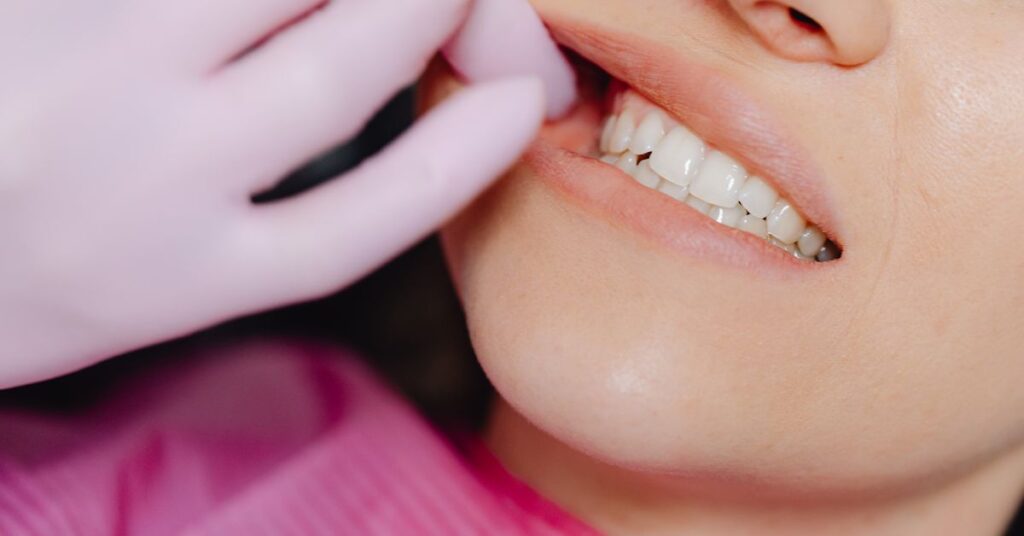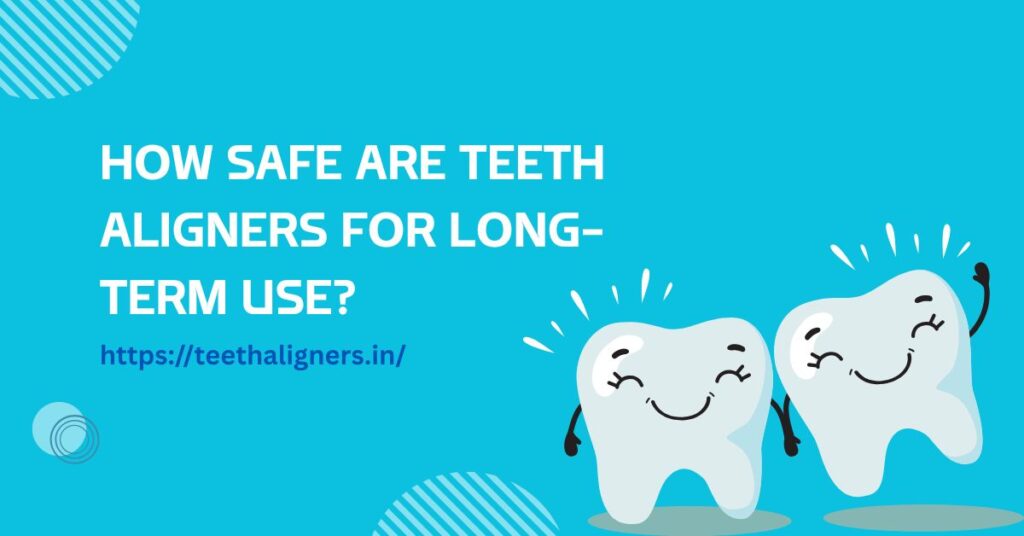In recent years, more people—especially teenagers and adults—have been choosing clear aligners to straighten their teeth instead of traditional braces. These trays look better, feel more comfortable, and are easy to remove.
But while aligners seem like a smart and modern option, it’s natural to wonder: Are they really safe to use over the long term?
To help answer this, we’ll take a close look at how aligners work, what dentists and researchers say, and what people in India have experienced after using them for years.
Table of Contents
ToggleWhat Are Teeth Aligners?
Clear Aligners vs Braces
Teeth Aligners are custom-made plastic trays that gently push your teeth into a better position.
They’re see-through and designed to fit snugly over your teeth, making them nearly invisible—earning them the popular name Invisible Braces.
Unlike metal braces, they don’t use wires or brackets, so there’s less irritation to the mouth. Most people like that they can take the trays out when eating or brushing, which makes daily life easier.
Braces, on the other hand, stay fixed to your teeth throughout the treatment. They can be more noticeable and sometimes uncomfortable, but they’re still necessary for treating certain complicated dental problems.
How They Work Over Time
The process begins with a digital scan of your mouth. From this scan, several sets of trays are created, each designed to move your teeth slightly.
You wear each set for about one to two weeks, and with every change, your teeth shift just a bit more. The treatment usually takes 6 to 24 months, depending on the condition of your teeth.
Over time, the gentle and consistent pressure from the trays helps align your smile without pain or major disruption to your life.
Are Teeth Aligners Safe for Long-Term Dental Health?
The Materials and Design
The plastic used in Teeth Aligners is medical-grade, BPA-free, and has been tested to be safe for use inside the human mouth. It’s smooth, flexible, and doesn’t contain harmful chemicals.
This material has been used safely for years in dentistry and other health products, showing no signs of causing long-term damage when used properly.
The trays are made using 3D scans of your mouth, so each one fits your teeth precisely.
A good fit helps the aligners work better and reduces the chance of causing irritation or damage to your gums and soft tissues.
When aligners are properly designed and used under professional supervision, their long-term use is considered very safe.
Teeth Movement and Jaw Health
One common worry is whether moving teeth over a long time can harm your bite or jaw joints. When planned correctly by a dentist, the pressure applied is slow and controlled.
This careful approach avoids strain on your jaw or damage to the bone around your teeth.
However, problems can occur if the aligners are not used properly or if treatment is done without dentist supervision. Some people try at-home aligner kits, which may not include regular check-ups.
That’s risky. A trained dental professional knows how to guide your treatment and check for any early signs of trouble.
What Does Research Say About Long-Term Use?
Scientific Findings and Studies
Studies comparing clear aligners to traditional braces have found that both methods are effective when used correctly.
In fact, long-term follow-up studies show that people who use aligners often have stable results years later.
Some research also found that aligners may lead to fewer gum and root problems than braces because they are easier to clean and apply less pressure overall.
One report followed patients for five years after aligner treatment. The researchers found no harmful side effects linked to wearing aligners, and most people kept their teeth in the correct position—especially those who used retainers regularly.
Dentists’ Opinions and Monitoring
Many dentists now recommend aligners, especially for teens and adults with mild to moderate misalignment. Their main advice is to follow the treatment schedule closely and attend check-up appointments.
Monitoring is key. Dentists track how your teeth are shifting, look for signs of jaw discomfort, and make adjustments if needed.
Skipping these visits could allow a small problem to grow into something bigger, which is why regular dental care is an important part of long-term aligner use.
Real-Life Stories from India

Adult Patients’ Experience
In India, many adults are now choosing aligners over braces for personal and professional reasons.
For example, a 29-year-old IT professional from Pune used clear aligners for 18 months to fix crowding in her lower teeth.
Three years later, her teeth are still aligned. She says she wears her retainers at night and visits her dentist once a year for follow-ups.
This is a common story across major cities. Adults like aligners because they’re discreet, and the long-term results have been positive—especially when treatment is done with professional help.
Teenagers and Maintenance
Teenagers in India are also benefiting from aligners. A 15-year-old student in Ahmedabad completed a 12-month treatment plan and now uses a clear retainer every night.
Her dentist reported no side effects and praised the family for sticking to the care routine. Parental involvement helped keep the treatment on track.
Brands like Teeth Aligners in India are seeing more families choose clear aligners for their children, as long as proper usage and dental follow-ups are maintained.
How to Use Aligners Safely Over the Years
Tips for Daily Use
Wearing aligners the right way is important not just for results, but also for your overall oral health and safety. To get the best outcome, they should be worn for 20 to 22 hours every day without fail.
Taking them out during meals and when brushing your teeth is perfectly fine, but aside from those times, they need to stay in place to keep your treatment moving forward.
It’s also essential to clean your aligners at least once a day using lukewarm water and a soft toothbrush. This helps remove any food particles or saliva buildup and prevents bacteria from collecting on the trays, which could lead to bad breath or gum issues. Never use hot water, as it can warp the plastic and ruin the fit.
Also, be sure to avoid eating or drinking anything other than plain water while wearing your aligners. Foods and coloured drinks—like coffee, juice, or soft drinks—can stain the trays or weaken the material over time.
Keeping your aligners clean and wearing them consistently is key to getting the smile you’re aiming for.
Importance of Dental Check-Ups
Seeing your dentist during and after treatment is just as important as wearing the aligners themselves. Dentists check for
During your aligner treatment, regular check-ups help your dentist track how well your teeth are moving. They’ll look for steady, healthy progress with each new tray.
These visits also help catch early signs of gum or bone problems, like inflammation or recession, which can affect your results if not addressed.
Over time, your dentist might also check whether you’ll need new retainers to hold your teeth in their new position—especially if your current ones are worn, loose, or no longer fitting well.
Keeping up with these appointments ensures your treatment stays on track and your smile stays stable.
Even after your teeth are aligned, regular visits help keep your mouth healthy and your smile straight.
Are There Any Long-Term Side Effects?
Minor Issues That Can Happen
Like any dental treatment, long-term aligner use can come with a few minor issues. It’s common to feel some soreness when switching to a new tray, especially during the first day or two.
You might also notice slight changes in your speech or a bit of dryness in your mouth. These effects are usually temporary and tend to go away as your mouth adjusts.
If aligners aren’t cleaned properly, they can start to smell or build up bacteria, which isn’t good for your oral health.
And after treatment, if retainers aren’t worn as advised, there’s a chance your teeth could slowly shift back to their old positions. Consistency and care go a long way in keeping your results stable.
How to Avoid Complications
The best way to avoid problems is to follow your treatment plan closely. Don’t skip trays or move to the next set early, even if your teeth look like they’ve shifted.
Each tray is part of a gradual process that works best when done on schedule.
Always clean your aligners properly and avoid using hot water, as it can warp the plastic. After your treatment ends, wear your retainers as directed to keep your new smile in place.
If something feels off—like a tray doesn’t fit well or there’s unexpected pain—let your dentist know right away. Catching small issues early can prevent bigger problems later.
Conclusion
Clear aligners have helped millions of people get the smile they want—and they’ve proven to be safe for long-term use. Their materials are trusted, their design is precise, and with good care, they offer lasting results.
Dentists and researchers agree that when used under proper supervision, Teeth Aligners in India are a dependable way to improve dental health without harming your bite, gums, or jaw.
In India, more people are making this choice every day. Whether you’re a student or working adult, aligners can be a smart and safe solution—just remember to stick to your plan, visit your dentist, and take care of your trays.
If you’re thinking about starting your journey to straighter teeth, talk to a dental professional who understands aligners and long-term care. Your future smile will thank you.

